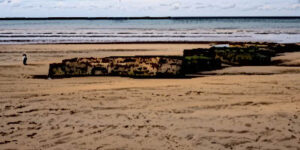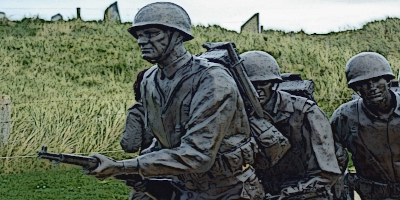D-Day Invasion Attack June 6, 1944
Learn about the D-Day Invasion Attack June 6, 1944 During World War 2 Read more about the D-Day Invasion Attack June 6, 1944 >>
D-Day Invasion Plan
Learn about the D-Day Invasion Plan During World War 2 Read more about the D-Day Invasion Plan >>
D-Day Landing Beaches
Discover the D-Day Landing Beaches in Normandy France Read more about the D-Day Landing Beaches >>
D-Day Meaning
Learn about the meaning of the Words 'D-Day' used During World War 2 Read more about the D-Day Meaning >>
Famous People of the D-Day Landings List WW2
Famous People of the D-Day Landings during WW2 Read more about the Famous People of the D-Day Landings List WW2 >>
Importance of D-Day
Discover the Importance of D-Day in the History of the World Read more about the Importance of D-Day >>
Purpose and Result of D-Day Landings
History or World War 2 and the D-Day Landings Read more about the Purpose and Result of D-Day Landings >>
D-day – Planning – Operation Overlord
In 1943, Germany still showed no signs of losing the war. The Allied needed a plan to somehow counter the Germans and regain hold in the European mainland. A plan was submitted for the D-day invasion in July 1943 by Lieutenant General Fredrick Morgan.
The planning involved gigantic staging operations of a large number of troops.
The plan paved the way for the Normandy Landings. General Dwight Eisenhower was the Commander-in-Chief of Operation Overlord. An elaborate deception was created and carried out in order to confuse the Germans about the intended site of the Allied landings on D-Day.
The deception worked and the Germans were taken off-guard when the Allied forces attacked Normandy.
Operation Bodyguard – The Great Deception
Operation Bodyguard was the name given to the elaborate deception plan meant to confuse the Germans about the D-Day.
The operation was planned to give Germans the impression that the Allied troops intended to invade North-eastern Europe.
An entire fake army under General George Patten was created for the purpose.
The Allied troops used inflatable aircraft, fake runs on runways, and fake troop movements to cement German belief in this decoy plan. To add to it, small sub-operations were also carried which supported the deception of Operation Bodyguard.
The deception was so complete that even Hitler and his innermost intelligence circles believed that the actual Allied landings were elsewhere.
This partly contributed to the German delays in responding to the Allied assault at Normandy which they believed was a minor assault until it was too late.
The Atlantic wall – Hitlers Great Defensive Barrier Wall
The Atlantic Wall was a massive defense barrier built along the northern coast of France expanding to Holland, Norway, and Belgium. The construction of this barrier was personally ordered by Hitler.
This great porous wall covered a distance of 1,670 miles and was the key bulwark in Hitler’s vision of ‘Fortress Europe.’
The Atlantic wall was built to repel the attack of the Allies on Nazi-occupied Europe. Most of the wall was built along the French coastline and was further extended with about nine thousand fortified positions.
The Allied had to face and overcome this so-called wall during their seaborne landings.
Weather Delays Cause Problems for Allied Troops
During the Normandy landing, along with many other things, the planning had to consider the weather conditions. Clear skies were crucial for air operations, whereas a full moon was needed for good visibility.
On the other hand, calm seas and low winds were required to transport the seaborne troops on the beaches. However, in spite of all precautions and planning, the weather on D-day was not ideal. Strong winds and rough seas rose problems for landing crafts, eventually making the beach hurdles harder to navigate.
Furthermore, on June 19, a severe storm destroyed one harbor, damaged the other, and temporarily distorted the critical build-up of Allied men and equipment.
The eventual landings of both airborne and seaborne troops were rough, often scattered, and somewhat disorganized.
Paratrooper Landings
The Allied leaders chose Normandy beaches for the landings because they were within the range of air cover and were relatively less heavily defended.
Paratroopers were dropped behind enemy lines to protect the flanks and open interior roadways for Allied troops.
On the first day, six divisions were to land whereas three were to follow up after the assault division. Nevertheless, the initial phases of the landing were marked by confusion, disorganization, and faulty implementation of plans.
Adverse weather conditions played a central role in this. The airborne landings scattered badly. However, most paratrooper units were still able to achieve their objectives.
Seaborne Landings on Five Beaches
Normandy landings were the largest seaborne invasion in human history.
It was preceded by aerial bombardments, naval support, and paratrooper landings. The seaborne landings took place along a 50-mile stretch. The 50-mile coast was into five zones: Utah, Omaha, Gold, Juno, and Sword beaches.
The weather was far from ideal and strong winds blew the landing crafts towards the east on the day of the seaborne landings.
Number of troops involved in D-Day Landings
Around 156,000 Allied troops landed on Normandy on D-Day. These included American, Canadian and British soldiers. The American forces landed about 73,000 troops, British forces landed 61,715 troops, and the Canadian troops numbered around 23,000. During the Battle of Normandy, nearly 425,000 combined troops on both sides were killed, wounded, or went missing. This figure includes the total casualties for both Germans and the Allied forces by the end of Operation Overlord.
The Liberation of Paris
Following their advances on D-Day, the Allied troops pushed on and reached Paris on August 19, 1944. The Liberation of Paris was a battle that began on this date and concluded nearly a week later. The German garrison at the city was able to put up little resistance. French resistance troops joined hands with the American troops to force the Germans to surrender. The loss of Paris was a psychological blow to the Nazi regime.
Surrender of Germany May 1945
On 7th May 1945, the German high command signed an unconditional surrender of all the German forces in northeastern France.
Initially, the General command hoped to restrict the terms of the German surrender to only the forces still confronting the western Allies.
General Dwight, however, demanded a complete surrender of all the German forces whether fighting in the east or west.
To make the demand forceful, Eisenhower threatened to leave German fate to the hands of the plundering Soviet troops. In the face of this pressure, Germany finally capitulated and all German armies effectively surrendered.
D-Day Landings Summary
- D-Day was the day of Normandy Landings on June 6, 1944.
- D-Day marked the beginning of Operation Overlord, the Allied plan to retake the European mainland from Germany.
- D-Day included both seaborne and airborne landings in Normandy.
- Seaborne landings took place along five beaches of Normandy. These included Utah, Omaha, Gold, Juno, and Sword beaches.
- A total of 156,000 Allied troops took part in the seaborne and airborne landings on D-Day.

